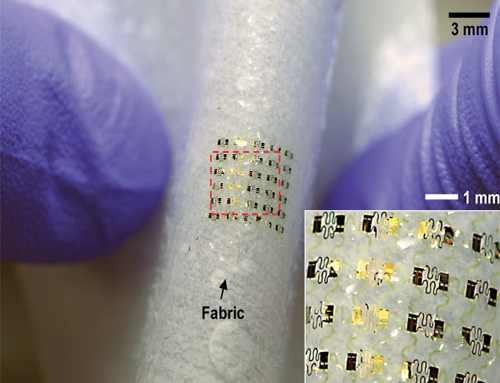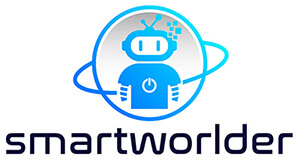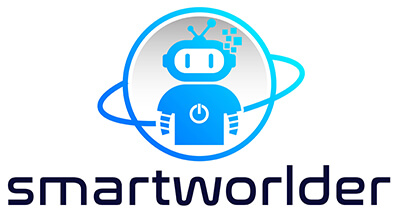Smart Textiles and Smart Clothing – The New Black for the Internet of Things
Content
– What is Smart Clothing?
– Smart Clothing for Rescue Workers, Healthcare and Military
– The Rise of Smart Fashion – History of Smart Clothing
– Examples of Smart Clothing
– Bottom Line
The impact of technology on the textile industry is no longer limited to the design and production environment of clothing. Now, technology is becoming part of the textile itself.
The future of your shirts, socks and gloves will be electronic. In years to come, wearable electronics will look nothing like even your smallest electronic gadget today. Not only will such devices be embedded on textile substrates, but an electronics device or system could become the fabric itself (see for instance: Nanotechnology e-textiles for bio-monitoring and wearable electronics). These e-textiles will have the revolutionary ability to sense, act, store, emit, and move – think biomedical monitoring functions or new man-machine interfaces, not to mention game controllers – while leveraging an existing low-cost textile manufacturing infrastructure.
Smart textiles pack powerful sensors and electronics in the weave of a material. These components are stretchable, breathable, even washable – and they are invisible to the eye.
In contrast to popular wearables like smartwatches and fitness bracelets, they don’t look like you are carrying around tiny computers. They are comfortable and easy to wear, they work around the clock in the background, or they can take periodic readings. Smart clothing can even be fashionable.
One of the biggest factors that play a part in the emerging electronic textiles industry is the advancement of nanotechnology. Intrinsic conductive nanomaterials such as carbon nanotubes, graphene, or metallic nanowires.
Following the same trend as other Internet-of-Things (IoT) devices, fabrics can be embedded with nanotechnology-enabled ultrathin, flexible and transparent sensors, actuators, electronics and power generation or storage. As these electronic components become smaller and all but invisible, self-powered electronic textiles (e-textiles) will range from smart fashion to smart fitness wear, data gloves and other human-machine interfaces will herald a new era of wearable electronics (for more, read our collection of Nanowerk Spotlights on various aspects of wearable electronics).
Take this example where researchers have incorporated metamaterials into conventional clothing to dramatically improve signal strength between wearable electronic devices. This innovation could have future applications in high-tech athletic wear and medical apparel.
What is Smart Clothing?
There are many synonymous terms used for electronic textiles – smart clothing, high-tech clothing, smart textiles, smart fabrics, intelligent fabrics, smart fashion, wearable electronics, smart wear, etc. – that have slightly different meanings but generally overlap on the aspect of having electronic components in some shape or form embedded in or with the textile.
Smart clothing, or e-textiles, are fabrics embedded with ultrathin, flexible and transparent sensors, actuators, electronics, mobile connectivity, and even nanogenerators to power them. The combination of these components gives smart clothes new functionality that improves their performance and usefulness for the wearer when compared to their non-smart counterparts.
One of the key challenges for smart clothing is the requirement to achieve and combine different properties like flexibility, user comfort, and ability for the components to be miniaturized (and fashionable). To do this, researchers are making use of different materials like nanomaterials, polymers, dielectric elastomers and composites. These are tailored to specific application depending on their different characteristic behaviors upon different stimuli. Read more in our primer "How nanotechnology enables wearable electronics".

Smart clothing is more than glamour. Before we visit the fashion houses of Milan and Paris, let’s look at some practical, even lifesaving uses of smart clothing.
Smart Clothing for Rescue Workers, Healthcare and Military
A great example of smart clothing in a work environment is for emergency first responders such as firefighters and rescue workers. The goal is to improve their safety, coordination and efficiency and the survival management they provide for civilians.
By integrating electronic components, sensors and interconnectivity directly into protective garments, a wide range of functions can be accomplished:
Similar protective smart clothing can be used in other areas such as health care, building workers, transportation maintenance. Of course, the military is an early adopter of these technologies as well.
By embedding electric, electrochemical and optical sensors into a textile substrate it is possible to create sensing patches that able to monitor the biochemical parameters of a user. These sensors can monitor bodily fluids such as blood, sweat and urine of the wearer throughout the day (and night). They could find applications in medical monitoring from diapers to hospitals to elderly care.
Advanced polymers for the clothing sector will allow micro-encapsulation of small particles in the textile for release, allowing to add a fragrance or therapeutics.
Virtual reality (VR) and augmented reality (AR) are rapidly gaining importance not only for gamers but also in military and industrial environments. Interactive textile electronic devices will provide suitable platforms for VR/AR applications because of their excellent performance and unique immersive features such as lightweight, handiness, flexibility, comfort, and low strain even under high deformations.
The Rise of Smart Fashion-History of Smart Clothing
Although not really ‘smart’ clothing, perhaps one of the earliest entries of technology components in the textile industry was Zegna's launch of a solar-powered jacket in 2007. The jacket had two solar modules integrated into the collar, which each generated about 1 watt of power in sunlight. The electricity is routed via conductive textile cables to a buffer battery, which can be used to charge a smartphone directly or store the power until needed.
In 2010, Abbey Liebmann, during the Cornell University's 2010 Design League Fashion Show, displayed a solar-powered dress featuring ultra-thin flexible solar cells linked through conductive cotton yarn to a USB charger allowing wearers to power an iPod or a mobile phone. The dress was designed with cotton fibers coated with a combination of nanoparticles and semiconductor polymers. Surprisingly, the cloth moves and feels as though it is made with regular cotton.
Then there is CuteCircuit’s SoundShirt that creates an immersive augmented and virtual reality experiences thanks to the haptic actuation modules.
A leading luxury fashion house began exploring the future of smart fashion in 2010. Gucci took an interest in and fully supported the Textile Futures Research Group at the University of Arts in London. This was an effort to facilitate technological convergence in textiles as well as to elevate the interface between design and science.
Currently, different fashion brands have invested in the smart clothing sector. Some common brands already taking up this space include Samsung, Levi's, Google, Ralph Lauren, Tommy Hilfiger, Nike, Under Armour and Komodo Technologies.
Companies like Loomia are at the forefront of commercializing wearable electronic circuitry. The Loomia Electronic Layer (LEL) is a soft, flexible circuit layer that's perfect for auto interiors, soft robotics, and of course, wearable technology.
Examples of Smart Clothing
Currently, several clothing and tech brands are still playing around with the concept of smart garments. Smart garments (smart clothing) can do a lot than the traditional work of clothes, from tracking heart rates to monitoring human emotions, picking up calls, and even paying for a quick service or product. From yoga pants to socks and several other garments, below is a compilation of smart clothing designed by their parent companies.
Google's Project Jacquard
One of the first connected clothing launched by Google's Project Jacquard platform is the Levi's Commuter Tracker jacket. The jacket's sleeve features touch and gesture-sensitive spots that allow users to interact with various services like music apps. By interacting with such spots, you can dismiss phone calls or perform any other function without reaching for your phone.
Ambiotex
Ambiotex designed a smart shirt with the serious athlete in mind. The smart shirt has a compression-style fit, meaning you need to be in decent shape to be able to pull it off comfortably. It has integrated sensors functioning alongside the clip-on box to record data.
Using this combination, the Ambiotex shirt can measure your heart rate variability, stress levels, anaerobic thresholds, and fitness levels. You can view the collected data on the accompanying smartphone app, which also has additional training programs.
Nadi X Smart Yoga Pants
Nadi X is one of the most futuristic smart wear, designed by Wearable X, a leading fashion tech company fusing tech and design to create an improved quality of life. Nadi X yoga pants feature built-in haptic vibrations that pulse gently at the hips, ankles, and knees, encouraging you to hold or move positions.

The pants sync to your phone via Bluetooth through its associated app that provides you valuable feedback. Nadi X pants come in different colors and sizes to accommodate different needs.
AIO Smart Sleeve
Komodo Technologies launched a compression sleeve that utilizes electrocardiogram (ECG) tech to monitor heart rate activity. The sleeve also monitors sleep and workout intensity. In addition, the sleeve's module features sensors that monitor body temperature, UV rays, and air quality.
Nike Adapt
Nike Adapt is a lacing system that electronically adjusts to the shape of your foot. Get the right fit, every game, every step. Instantly adjust your Nike Adapt shoes, check battery levels and more using just your smartphone. Five customizable voice commands work with Siri Shortcuts—or Google Voice, for Android users. The Nike App comes loaded with two preset fit modes: one tuned for activity and the other for relaxing. You can easily create your own with custom modes, as well.
Hexoskin
Hexoskin Smart Garments include textile sensors embedded into comfortable garments for precise and continuous cardiac, respiratory, and activity monitoring. Hexoskin users can visualize, report, and analyze their data with the leading Hexoskin Connected Health Platform.
Under Armour Connected
Under Armour has embedded a high fidelity sensor in the mid-sole of the right-footed shoe that digitally connects seamlessly to the MapMyRun™ app via Bluetooth™ Low Energy (BLE). The sensor is fully protected from the elements and will last the lifetime of the shoe without needing a charge. This simple, seamless connection allows the UA HOVR shoes to track a variety of metrics and data on your run, including distance, pace, splits, cadence, stride length, and lifetime distance.
JanSport Smart Backpack
JanSport teamed up with an MIT lab to create a smart backpack. The prototype is made with a programmable fabric that allows you to share your music or social media with anyone nearby.
Owlet Smart Sock 2
Unlike the first generation, this second-generation Owlet Smart Sock encompasses new features. The smart sock uses pulse oximetry technology to monitor a baby's heart rate while ensuring an uninterrupted breathing or sleeping pattern. It syncs up to an iPhone or Android phone to deliver data in real-time.
In addition, it has an increased 30 meter Bluetooth range and better-placed sensors for more accurate readings. In conjunction with Owlet's new Connected Care platform, the smart sock can help you identify potential health challenges like sleep irregularities, chronic lung disorders, bronchiolitis, heart defects, among others.
Samsung NFC Suit
Samsung has already shown significant interest in the smart textiles industry by introducing its Body Compass workout shirt that monitors biometric data. It has also introduced the Bean Pole Golf that monitors weather and UV ratings.

Samsung also has a NFC suit designed in collaboration with Rogatis that allows you to swap your business cards digitally, unlock your phone, and set gadgets to drive and office modes.
Bottom Line
Most advances in smart clothing are still happening in research labs. The few examples that have entered the market are demo projects, pilot studies or limited to a few simple functions. Tech and fitness enthusiasts are at the forefront of wearing out these smart clothes.
That will change in a dramatic way over the coming years. Think about the early days of mobile phones and today's smartphones. Smart clothing and all kinds of e-textiles will evolve on a similar trajectory.
Check out our SmartWorlder section to read more about smart technologies.



